Let us assume then that all Scots love their tartan. That done, we shall proceed to the following questions: What is tartan? Where did it come from? Who invented it? Why do Scots put such a high importance on it? If tartan is plaid, is plaid tartan? Is tartan plaid? These questions may be among the great mysteries of the universe though personally I doubt it. In the following lines this writer shall attempt to answer at least a few of these things which we may chance to ponder…
To understand tartan we must first understand weaving and to understand weaving we must understand spinning, and so forth and so on until we’re back to running around in naught but our skin. We’ll skip all that and jump ahead a few millenniums to the point where humans are dressed and weaving their cloth. Here then is the story of the tartan:
The Tartan: What, Where, When, Why?
First thing, the basics, starting with a definition of the term Tartan which is; A fabric, normally woven of wool that consists of stripes of varying width and color. These stripes run vertically (the warp), with matching stripes running horizontally, (the weft). The result is a pattern that appears to be squares crossed by stripes. This pattern is known as the sett. The final tartan is a repeating run of the sett. There are now varying weights of cloth produced as tartans and many, many various patterns representing not only the clans of Scotland but different governments, school, bands and many other organizations willing to pay for the design and manufacture. Tartans are probably the most recognizable symbol of our Scottish heritage today. It is estimated that there are between 3,500 and 7,000 tartans currently in use.
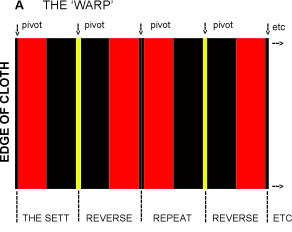 |
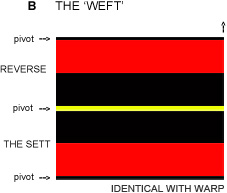 |
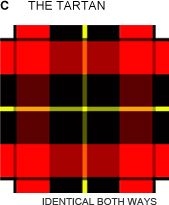 |
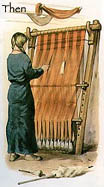
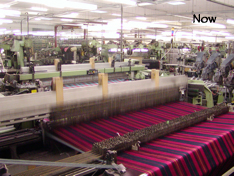 Early looms were functional but not terribly elegant, but probably worth a small fortune today. Celtic looms were made from strong wood. The warp threads were hung from the top bar and weighted at Early looms were functional but not terribly elegant, but probably worth a small fortune today. Celtic looms were made from strong wood. The warp threads were hung from the top bar and weighted at the bottom with chunks of clay to keep them taut. Using wooden shuttles the weft threads were then passed through the warp alternating from front to back. The warp threads were raised and lowered alternately to ease the passage of the shuttle. Today’s looms are mammoth computer operated electronic machines that pound out the tartans at an amazing rate. After the weaving is done the rolls of fresh tartan go to be inspected and any flaws found are deftly removed by hand by expert workers.
Early looms were functional but not terribly elegant, but probably worth a small fortune today. Celtic looms were made from strong wood. The warp threads were hung from the top bar and weighted at Early looms were functional but not terribly elegant, but probably worth a small fortune today. Celtic looms were made from strong wood. The warp threads were hung from the top bar and weighted at the bottom with chunks of clay to keep them taut. Using wooden shuttles the weft threads were then passed through the warp alternating from front to back. The warp threads were raised and lowered alternately to ease the passage of the shuttle. Today’s looms are mammoth computer operated electronic machines that pound out the tartans at an amazing rate. After the weaving is done the rolls of fresh tartan go to be inspected and any flaws found are deftly removed by hand by expert workers.
A common misconception regarding tartans is in the name; the word plaid is not synonymous with tartan. Tartans have a specific design pattern and normally are made of cloth; the sett is normally the same when viewed from any angle, there is no top or bottom to a tartan and is the same from either side as well.
A plaid, from the Gaelic and pronounced plaide, is a blanket used by the Highlanders to wrap themselves in for sleeping at night and worn as a garment during the day. The plaid is usually made of heavy tartan cloth.
Another misconception is that a person must belong to a clan in order to have the “right” to wear that clan’s tartan. Not so, you can wear any tartan that you like. As Turnbulls we are privileged to have very attractive set of tartans that represent our clan, but there are some tartans out there that, to some, may seem rather gaudy and/or grotesque. The manufacture of tartan is an industry that is not exclusive to Scotland; the Pendleton Mills on Oregon for instance produce some very fine, and legitimate, tartan cloth. These tartans may or not be registered but are still real tartans.
Tartans as we know them in the 21st century had their beginnings back in the mists of history. The name of the cloth itself has caused speculation as to its origin. One group believes that the word tartan comes from the Irish word tarsna which means crosswise and/or the Scottish Gaelic tarsuinn which means across. However, the Gaelic word for tartan has been and remains breachdan. It is widely believed though that the word comes from the French word tiretaine. Tiretaine was a fabric woven from a combination of wool and linen and was more a type of fabric rather than the pattern that was woven.
The Celts have woven checkered or striped cloth for many thousands of years. The standard belief is that the technique for weaving tartan was brought to the northwest part of Britain during the Iron Age when the Celtic Scoti (Scots) came from Ireland in the 5th or 6th century BC. There is evidence that the Romans found the Celtic tribes sporting brightly striped clothing. At the time there did not exist a word to describe checkered cloth. There is a sample of this ancient cloth in the National Museum of Scotland.  This sample is known as the Falkirk Tartan and was found being used to stopper for an earthenware pot buried close to the Antonine Wall near Falkirk, used to hold someone’s treasure of silver coins in the 3rd century AD. The material is a simple checked pattern of undyed brown and white wool of the native Soay Sheep.
This sample is known as the Falkirk Tartan and was found being used to stopper for an earthenware pot buried close to the Antonine Wall near Falkirk, used to hold someone’s treasure of silver coins in the 3rd century AD. The material is a simple checked pattern of undyed brown and white wool of the native Soay Sheep.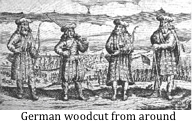 Originally the fabric was woven, as in the Falkirk Tartan, from the undyed fleece from the wee beasties we like to call sheep. As time passed and technology increased, the use of dyes from various plants was added to create the bright colors that make up the tartans of today. One of the earliest chronicles that mentions tartans comes from 1538. It seems that King James V bought “three ells1 of Heland Tartans” with which to dress his wife. Another old record dated 1587 has Hector MacLean (the heir of Duart) “paying feu duty2 with sixty ells of cloth ‘white, black, and green’” which were the traditional colors of the MacLean hunting tartan. There are other references to cloth that may have been tartans but the first hard evidence that we have comes from a German woodcut from around 1631 that shows men dressed in tartan great kilts.
Originally the fabric was woven, as in the Falkirk Tartan, from the undyed fleece from the wee beasties we like to call sheep. As time passed and technology increased, the use of dyes from various plants was added to create the bright colors that make up the tartans of today. One of the earliest chronicles that mentions tartans comes from 1538. It seems that King James V bought “three ells1 of Heland Tartans” with which to dress his wife. Another old record dated 1587 has Hector MacLean (the heir of Duart) “paying feu duty2 with sixty ells of cloth ‘white, black, and green’” which were the traditional colors of the MacLean hunting tartan. There are other references to cloth that may have been tartans but the first hard evidence that we have comes from a German woodcut from around 1631 that shows men dressed in tartan great kilts.
The belief that the tartans were clan related is not true, rather it was a regional thing with the weaver of an area designing a pattern with the wools that were available to him, (commercial weavers at the time were invariably men). In time this pattern became a sort of District Tartan but not necessarily a Clan Tartan. Since the local communities were basically large extended families usually living entire lives in close geographical proximity, in a glen or strath3. With this lifestyle, they tended to adopt the tartan pattern that the local weaver, most likely a relative, produced. It was more of a convenience thing rather than clan pride. A Scotsman won’t travel far for a product that he can get nearby after all. It did not take long before the District Tartans became associated with the communities and therefore the clans that wore them. Thus we have Clan Tartans.
The stories about tartans being used as clan symbols and/or uniforms during the Jacobite rebellion of 1745 are, for the most part, myth. The Jacobite army was arranged with the warriors in groups by region and since they usually dressed in the tartan that was manufactured in their home region these same tartans became identified with the men from that region of Scotland, normally members of the regional clan. Actually there were tartans that appeared on both sides of the battle. Truth be known many of the Scottish warriors would discard his philamhor (belted plaid) when entering battle. What the clans then did was to attach a piece of ribbon or sprig from plant to their bonnet thus identifying the clan affiliation.
As for the designs of the early tartans the weavers depended on the natural color of the wool, then the natural dyes that they learned to make mostly by trial and error experimentation. This would explain some of the distinct hues of some tartans in that plants and others source in one area of Scotland were not available in others. On the coastal regions for instance; Gipsywort produced a nice green while seaweed rendered flesh colors and seashore whelks resulted in purple. Farther inland the dye makers turned to the moors for their source of color; heather could be treated to give varied colors from green to yellow and brownish orange, blueberries produced purples, browns and blues and lichens gave him a varied and large range of the more subtle shades. Later as the technique evolved the weaver would obtain dye making supplies from other source throughout Europe.
Following the battle of Culloden and the genocide that went on throughout the highlands the “government” wanted to obliterate the Clan System in Scotland. They passed the Disarming Act of 1746 part of which made the wearing of tartan a punishable offense. Now we know that punishment then was not the same as now. Folks were hung for the most minor of offenses, and that was the nice way to die considering the various methods in use during that era. The law however only applied to the common Highland men and not the upper echelons of Highland Society or the lowland Scots or women. It also and more importantly did not apply to the Highland regiments that were assembled by the self same government.
These laws were in place for 36 years until 1782 when they were repealed. The newly regained freedom caused a resurgence of Scottish nationalism with the formation of Highland Societies in both Edinburgh and London. Sir Walter Scott can be credited with much of the popularity of Clan Tartans. In 1822 he persuaded Highland Chiefs to attend functions organized for the visit of King George IV. The chiefs came in full Highland dress, each wearing the Tartans that were now known as Clan Tartans. Immediately following the visit of the English king the Clan Tartan became an overnight sensation with families proudly displaying their families own Tartan. Some of these new converts had previously hated the Highlanders. Scott also romanticized the life in the Scottish countryside adding to the popularity of the tartan which now became synonymous with the clan. Later, Queen Victoria and Prince Albert contributed to the loving relationship we hold with our tartans. The young couple found their beloved Balmoral, the royal residence on Deeside in Scotland. The Prince Consort designed the famous Balmoral Tartan which was used throughout the castle. The Balmoral Tartan is generally held exclusive to the royal family.
The naming of clan tartans and the registration thereof began in 1815 when the Highland Society of London decreed that the clan chiefs, respectfully, should submit a large sample of their specific tartan to the Society for verification registration. Some of these chiefs however had no idea what their Clan Tartan was by since they wished to comply with the request they had to search out the tartan that had become associated mainly with the particular clan. The Clan Tartan is an important part of our Scottish heritage today. Most of the clans now have one or more tartans that bear the Clan name. We Turnbulls have three, Dress, Hunting and Ancient though none are very old by the standards of Scotland’s past. The Turnbull Tartans are a combination of the Douglas and Bruce Tartans; the Dress Tartan was created in 1979 and the Hunting in 1983.
Dress tartans differ from the hunting version in that a prominent color is replaced by white. This is the tendency but not the rule. There really are no rules regarding the design of tartans. Anyone can design a tartan and anyone can wear any tartan that appeals to them. Many clans now have an official tartan representing the clan. Only the Chief of the clan can make a tartan an official clan tartan. Some, but not all Clan Tartans are recorded and registered by the Lord Lyon King of Arms. Once approved by the Lord Lyon the tartans are entered into the Lyon Court Books.
Today the manufacture and sale of tartan cloth and the products made with that cloth is a multi-million pound (or dollar if you prefer) industry; an industry that is dominated by a few large mills in Scotland. We toured the Lochcarron Mill in Selkirk on the Scottish Border when we were there a few years ago. Also, tartans are not limited to use in fabric and clothing. There are many objects sporting tartans. From coffee cups to jewelry boxes, you name it and a tartan can be incorporated into the design. The Tartan has become a major symbol of our Scottish heritage along with kilts, heather, bagpipes, and Scotch.
1.An ell was the measure of a man’s arm from shoulder to fingertip and thus varied from seller to seller, or buyer
2. Feu duty is a term from the feudal past that was the annual payment made by the owner of a building in Scotland to the nominal feudal superior for the right to use the land or property.
3.A strath, from the Gaelic word srath, is a large valley, typically a river valley that is wide and shallow (as opposed to a glen which is typically narrower and deep).
